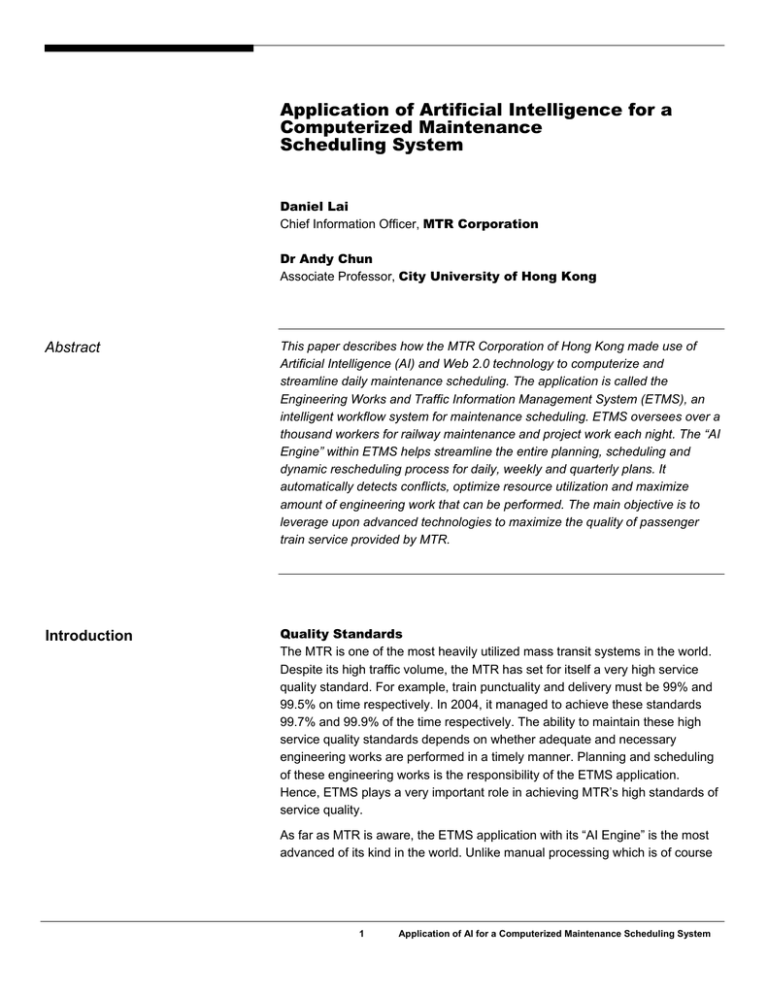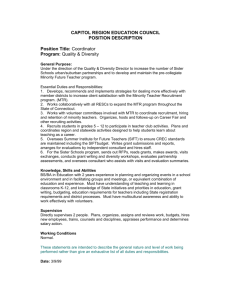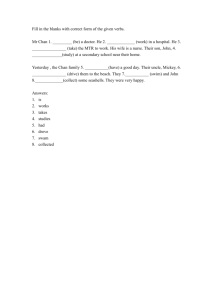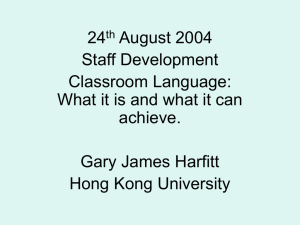Application of Artificial Intelligence for a Computerized Maintenance Scheduling System
advertisement

Application of Artificial Intelligence for a Computerized Maintenance Scheduling System Daniel Lai Chief Information Officer, MTR Corporation Dr Andy Chun Associate Professor, City University of Hong Kong Abstract This paper describes how the MTR Corporation of Hong Kong made use of Artificial Intelligence (AI) and Web 2.0 technology to computerize and streamline daily maintenance scheduling. The application is called the Engineering Works and Traffic Information Management System (ETMS), an intelligent workflow system for maintenance scheduling. ETMS oversees over a thousand workers for railway maintenance and project work each night. The “AI Engine” within ETMS helps streamline the entire planning, scheduling and dynamic rescheduling process for daily, weekly and quarterly plans. It automatically detects conflicts, optimize resource utilization and maximize amount of engineering work that can be performed. The main objective is to leverage upon advanced technologies to maximize the quality of passenger train service provided by MTR. Introduction Quality Standards The MTR is one of the most heavily utilized mass transit systems in the world. Despite its high traffic volume, the MTR has set for itself a very high service quality standard. For example, train punctuality and delivery must be 99% and 99.5% on time respectively. In 2004, it managed to achieve these standards 99.7% and 99.9% of the time respectively. The ability to maintain these high service quality standards depends on whether adequate and necessary engineering works are performed in a timely manner. Planning and scheduling of these engineering works is the responsibility of the ETMS application. Hence, ETMS plays a very important role in achieving MTR’s high standards of service quality. As far as MTR is aware, the ETMS application with its “AI Engine” is the most advanced of its kind in the world. Unlike manual processing which is of course 1 Application of AI for a Computerized Maintenance Scheduling System error-prone and not optimized, an AI approach provides highly optimized solutions to maximize quality of service. The 2.4 million passengers who use the MTR each day benefit from the crucial planning and scheduling decisions made by ETMS in keeping passenger trains running smoothly and trouble-free. Figure 1: One of the screens in the ETMS application The Challenges Night-time engineering works ensure passenger trains run smoothly during the day. However, deciding which set of engineering jobs should get done each night and by whom and with what equipments is a highly complex decisionmaking process. Numerous safety and operational rules and constraints must be followed as well as making sure all required resources will be available at the right locations. Through the use of AI, our application streamlines and automates quarterly planning and weekly scheduling of all engineering works to be performed at night during non-traffic hours within MTR such that resource utilization is maximized. Thus, allowing more work to be done with the same set of resources and ensuring all rules, regulations and guidelines are followed. We estimate that ETMS resulted in an overall efficiency improvement in the possession planning process of at least 51% and significant savings in time and cost. Application of AI for a Computerized Maintenance Scheduling System 2 Optimal Use of Non-Traffic Hours Every night after normal traffic hours, hundreds of engineering works are performed in various MTR stations, tunnels, track-side areas, and ancillary buildings. These engineering works are necessary to ensure smooth daytime passenger train services as well as enhance various station facilities. An example is the Platform Screen Door Retrofit Project. The challenge of this project is that the workers have to work with engineering trains at up to 10 different platforms each night, whilst still being able to schedule the routine maintenance works. As a result of intelligent planning, the Platform Screen Door Project is on time and within budget without impacting on the nightly maintenance of the railway. Unfortunately, engineering works can only be performed during “non-traffic hours” (NTH), i.e. from 1:30am to 5:30am – a relatively short period of time. The ability to produce a highly effective plan that maximizes the amount of crucial work done within this precious time period is critical to maintaining high quality of service standards provided by MTR. This is handled by our AI optimization algorithms within ETMS. Innovative AI Techniques The AI Engine captures and encodes valuable domain and expert knowledge on the operations of MTR engineering works as well as safety requirements and guidelines to automatically optimize how track possessions, engineering trains and personnel resources are assigned to various engineering works. Within the heart of the AI Engine is a sophisticated software model that simulates in fine details the operating environment within all the MTR train lines. The technology and approach used by the AI Engine is quite unique; it combined a novel non-intrusive approach to AI business rules with a hybrid scheduling algorithm based on genetic algorithms (GA) and heuristics search. Previously, only a handful of experts are fully qualified to analyze engineering works for operational correctness and safety. Probably, the most important benefit of the AI Engine is that it now allows invaluable expert knowledge on rules and regulations relating to engineering works and their safety to be available to over a thousand users at all times. This greatly improves the overall effectiveness of planners at MTR and its contractors. Innovative Web 2.0 Techniques The ETMS application is a Web-based Rich Internet Application (RIA) that utilizes state-of-the-art Web 2.0 techniques to provide a highly user-friendly environment similar to traditional desktop applications. ETMS uses AJAX architecture with JavaScript front-end. This is supplemented with SOAP-based Web services and interactive Scalable Vector Graphics (SVG) to display track circuits and possessions. 3 Application of AI for a Computerized Maintenance Scheduling System Streamlined Workflows ETMS plays an important and crucial role in the overall MTR operations. Planners from various engineering and operations departments as well as external contractors use the Web-based ETMS routinely to make engineering work bookings. Starting from the first step in the planning cycle, the ETMS AI Engine helps streamline processing. Each booking is automatically reviewed and analyzed by the AI Engine for correctness, resource availability, safety and conflict assessment. An automated suggestion is then generated by the AI Engine to assist the human planner in correcting and refining their engineering work requests. The AI Engine streamlines the booking processing by allowing issues and problems to be resolved as early as possible and up front at the initial booking stage. Many of these issues and problems will need human negotiations to be resolved. The AI Engine not only automates the scheduling process, but also assists with streamlining the human aspects of the workflows. Then, on a weekly basis, ETMS automatically takes all the requests made and generates an engineering works possession plan using AI. It does this using an optimization algorithm that tries different combinations of assignments as well as merging different bookings together to save valuable resources. After weekly assignments have been made, any changes or amendments will also be automatically reviewed and assessed by the ETMS AI Engine. Benefits Improvements in Productivity Productivity is achieved by the increase of efficiency and utilization of resource in engineering works at Non-Traffic Hours. For example, before using the ETMS, “no show Pedestrian Access” and “Unscheduled Pedestrian Access” rates were about 30% and 50% respectively. After the ETMS was implemented, they became 4.1% and 6.4% respectively in February 2005. With the AI Engine parties involved in engineering works can work more efficiently and effectively. For example, previously a request for engineering work possession may take a week before any feedback can be given. With the AI Engine, feedback (in terms of request feasibility, resource availability, safety and potential conflicts with other requests) is given immediately within seconds. This allows hundreds of planners to immediately refine or change their plans if needed instead of waiting several days to a week. The actual weekly scheduling process is also highly streamlined. Instead of having several senior managers use several hours each week to design a plan, the AI Engine automatically proposes a detailed plan prior to the meeting – a plan that meets all the MTR regulations and guidelines, is totally safe and maximizes resource utilization and the amount of work done. The meeting is now used mainly to review and approved the automatically generated plan. The Application of AI for a Computerized Maintenance Scheduling System 4 weekly Engineering Works planning meeting has been transformed from a paper based to a real-time on-line system which eliminates the need for staff to transcribe amendments from paper to the computer after the meeting. This has significantly relieved the burden of Planners and Traffic Notice production staff. Faster Amendments Amendments and changes are also streamlined. Amendment request forms in the past are collected and then processed in batch; a request may take several days to process. With ETMS, amendments are now immediately analyzed by the AI Engine and passed to the approvers. The net result of using ETMS is that over a thousand users get feedback and results quicker –in seconds and minutes rather than days and weeks; thus greatly improving the productive of the overall planning process. Convenient Web Access Since ETMS is web-based, planning activities can now be extended to external contractors. Hundreds of contractor staff can now book their own engineering work requests directly into ETMS. This greatly improves productivity by eliminating delays and communication time between contractors and MTRCL staff in performing manual booking. Since information on all engineering works, both internal and external to MTR, are now entered and updated immediately via the Web, all parties involved can now plan their work more efficiently and productively, being aware of all other engineering work activities. Paperless An effective planning process enables an effective implementation control of engineering works. Papers and forms are no longer required for traffic controllers and depot train controllers to register the engineering works that are carried out. Planning and implementation activities are more integrated with ETMS as planning information on engineering works are also made available to controllers. This eliminates unnecessary telephone calls and paper reports which in turn enables workers to start the engineering work quicker. Controllers can monitor the status of the engineering works effectively in a user friendly manner, work start/end times are also tracked automatically by the system. Faster Track Access Another example is in reducing process time for track access granting by a traffic controller. A typical track-side engineering work track access granting is reduced significantly from 1 minute 15 seconds when done manually to only 33 seconds with ETMS – less than half the original time. The ultimate result is an 5 Application of AI for a Computerized Maintenance Scheduling System improved utilization of resources and the non-traffic hours and getting more work done in the limited time period. With an effective implementation control provided by ETMS, safety for track access is further improved. Controllers have a better picture on all the working parties during the busy non-traffic hours. Moreover, they can ensure that tracks are clear with better information access to make critical decisions such as when it is appropriate to switching on the traction current for running of the first morning train. ETMS improves the safety of track access management and provides more visible, accurate and timely information on engineering works around the railway. Streamlined Communications The whole engineering work planning and implementation process involves many parties. ETMS has streamlined most of the communication between different these parties. For example, engineering works that generate noise during implementation are required by regulation to report to the Environmental Protection Department. This weekly manual communication task is now replaced by an automatic daily ETMS process which saves time as well as guarantees accurate and up-to-date information are reported. Longer Term Planning Engineering works planning can now be undertaken up to a year ahead with no need to enter data in multiple systems. Beside a planning system, ETMS is also used from 1 year ahead up to the time of execution of the engineering works. Conclusion Competitiveness To be a world class railway, one of the MTR corporate strategies is to provide the highest quality service to the general public with the best safety performance for passengers and engineering staff. MTR has consistently outperformed other operators world wide on these measures year after year. Engineering work management provided by ETMS directly supports this corporate strategy. An effective and efficient management of engineering works brings along a high standard of service quality and safety. A safe and reliable train service is essential for MTR to remain a leading and competitive transportation company. Since MTR is renowned internationally for its safe and reliable railway service, MTR is diversifying her business and extending to more and more consulting services worldwide. The knowledge of engineering work management and the use of AI in MTR interest other metro companies around the world. ETMS – an Application of AI for a Computerized Maintenance Scheduling System 6 end-to-end planning and implementation application for engineering works – serves as a reference model in the MTR consulting business. Summary The ETMS application demonstrated that innovative use of IT can substantially contribute to maximizing the quality of service provided to millions of Hong Kong citizens while improving productivity and cost effectiveness within the corporation and its business partners. ETMS has improved the international competitiveness of MTR with its ground-breaking use of AI for engineering works management and has put MTR in worldwide leading position on its use of IT. References Chun, H.W., Yeung, W.M., Lam, P.S., Daniel Lai, Richard Keefe, Jerome Lam, Helena Chan, "Scheduling Engineering Works for the MTR Corporation in Hong Kong," In Proceedings of the 17th Conference on Innovative Applications of Artificial Intelligence, Pittsburgh, July, 2005. What is Web 2.0? http://oreillynet.com/pub/a/oreilly/tim/news/2005/09/30/what-is-web-20.html AJAX: A New Approach to Web Applications http://www.adaptivepath.com/publications/essays/archives/000385.php 7 Application of AI for a Computerized Maintenance Scheduling System




